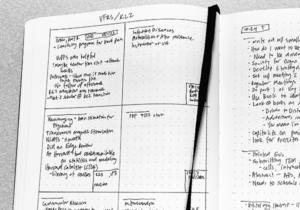How to Host a Multidisciplinary, Near-Peer Work-in-Progress Group
Work-in-progress groups (WIPs) convene members on a regular schedule for supportive critique of scholarly materials, including presentations, posters, manuscripts, cover letters, grant applications, and responses to reviews. WIPs are accepted as a career development best practice for enhancing productivity and professional polish.
Though groups are often organized around lab teams or with similar level trainees, I’m an advocate for WIPs that aim to build the “multidisciplinary tribe” by creating a community of scholars across disciplines, who are using varied research approaches, and who are at different career stages.
For three years we have hosted WIPs as a proactive means to connect pre-docs, post-docs, and early career faculty. Our rationale is that facilitating familiarity in intentionally-formed, near-peer groupings will:
- Inculcate low-threat approaches for giving and receiving review and critique,
- Foster greater scientific fluency,
- Allow members to find new intellectual common ground,
- Encourage participants’ embracing larger scientific territories in their research,
- Promote peer mentoring as a norm,
- Enlarge the professional networks of all participants,
- Create a group of individuals invested in each others’ success, and
- Lay the foundations for genuine community among researchers.
These results are being achieved. Interest in forming new WIP sessions is out-stripping our ability to make groups available.
How to Cook Up Your Own WIP
To get started you’ll need:
One or more experienced researchers who are effective mentors in group settings.* Ideally this would include scientists who span the types of research of the intended group as well a statistician or study design methodologist. Four mentor-level faculty on the WIP roster allows for travel and competing commitments so that you can typically achieve two or three in attendance.
Group of scholars to invite who are actively working on academic materials and can dedicate time to the group. We have hand selected members for light adjacency but not overlap of research areas (e.g. basic neuroscience, imaging, movement disorders, Alzheimer’s, age discrimination, and de-prescribing) and have also formed inclusive groups based solely on personalities we assessed would fit well together. Either approach can work well, and behind-the-scenes shaping of the group to be invited is helpful.
Ideal members are typically graduate students far enough into dissertation work that they are writing papers and preparing for talks, post-docs, and early career faculty, dedicated to research careers who do not have a heavy clinical or teaching load. Ideal group size is achieved by overshooting on invites and membership. If you want eight scholars and two mentor-level faculty present at most meetings, inviting 18 to 24 people to a predetermined time and place will get about 12 to 14 members joining the group on an ongoing basis. With travel, parental leaves, and other competing demands, this will result in 8-10 in attendance at most sessions. Sample invitation.
Recurring time and place to meet. We suggest weekly or biweekly for 1.5 hours to assure members have opportunities for almost all of their materials to have group review. Plan to take a summer hiatus and a shorter winter break.
Format. Once the group has a routine, they typically use the first 5-10 minutes for updates, to celebrate wins, and to share accountability items like SMART Goals. Then five to 25 minutes for review of the key portions of written materials or to present a practice talk. The balance of the time is used for discussion and suggestions. Repeat as needed to accommodate multiple presenters. To structure discussion time, we’ve used a Zoom In Review method in which feedback is structured from highest conceptual critique to fine detail as time and scholar readiness allows.
Shared calendar for members to book into to reserve slots for reviews and to commit to having materials ready. This promotes accountability to the group and to their professional timelines, as well as helping prevent procrastination. You’ll want some general conventions for which items can fit together in a single session and which can schedule for the full session. For instance, one abstract and a cover letter can both be reviewed in a single meeting. New grant aims or the results section and tables for a manuscript would each reserve a whole session.
Projection system and white board or flip chart to facilitate review of a range of items. The usefulness of the projector extends past rehearsal of talks into live group editing of documents projected on the screen. A place to write or draw is used by visual thinkers to show what they mean with regard to outline of a section or improvement of a figure, while at other times it serves as a site to make a “parking lot” of issues to be discussed about the work in subsequent sessions or for addressing with mentors when time is running short.
Provide paper copies of items to the group at the meeting for written mark-up and notes. This is essential since materials are reviewed in real time (requiring prework for WIPs consistently fails and adds to burden of participating). Even with effective moderation not all comments will be able to be made in the time allotted. Some edits, such as typos, can easily be passed along on paper and the author/presenter will have more ability to concentrate on feedback if not focused on note taking. For posters, print out in large format like 11×14, for slides print the 3-slides per page version with space for notes. For review of manuscripts, to constrain the time the group will often need to focus on a single section, but it is helpful to print the whole draft for context. For response to reviewers, print the reviewers’ comments or grant summary statements and provide any key supporting documents such as the aims page or concerning parts of a manuscript (or be prepared to project the manuscript).
Icing on the Cake
A Coordinator is ideal. If available, they will spend up to two hours a week to send reminders, circulate materials, bring printed items to the meeting location, have projection set up, and coordinate refreshments if possible. In DIY groups without a coordinator, participants are responsible for bringing printed materials and setting up projection.
Funds to pay for snacks, beverages or meals with rotating responsibility for set-up or help of a coordinator. Some of our group leaders and groups have created this perk by contributing to a discretionary fund through the development office so that donated funds can be directed to having lunches together during the WIP.
Getting Started and Building Group Culture
A printer-ready sample of our WIP Table Tent can be printed as tent cards and placed on tables in the room and the information can also be circulated in email as members agree to join the group.
In the first session the rationale for multidisciplinary, near-peer groups should be introduced by the faculty mentors or scholars who formed the group. Emphasis on the WIP being for review and critique of materials but also for encouragement, for accountability, and for seeking ideas and assistance is key.
In the first meeting, and often the initial few, introductions will be needed. To help people connect, we often ask participants to share:
- How long they have been at the institution
- Where their office or lab is located
- Who their mentors are
- What the most pressing project is that they are currently working on
We also ask one or two ice-breaker question to accelerate connections between members. Items that work include: What was the most fun you had last month? What’s your favorite pastime that’s not related to work? What’s the dullest trip you’ve ever taken? (Avoid asking about most interesting or exotic trips or adventures because this can stratify the room based on personality, financial means, or family structure.)
Connections form quickly around details the answers reveal like having children, looking for a new home, hobbies, or partners with details in common that are embedded in answers. Groups will start to share resources and life tips if you reintroduce such questions at the start of subsequent sessions and allow discussion to continue for a short time when members bring a trouble-shooting need into the conversation at the start of meetings.
Faculty mentors or other group leaders* should moderate use of time and infuse comments about the value of the group and thank participants for what they bring to the table. Discussion leaders must ensure commitment to gentle but direct comments. They will need to summarize, encourage brevity, or remind members to write down key items to give to the presenter in order to gather input from all in the room. Group leaders need to be prepared to restate or reframe commentary that could be or is being poorly delivered or received. At times this will extend to discussions with the group member outside the WIP to help them absorb and interpret the observations and advice.
To accommodate different levels of comfort and familiarity with critiquing the work of others, we’ve promoted use of the Zoom In Review in which comments are structured from highest conceptual critique to fine detail as time and readiness allows. See sample instruction cards to project before groups start or to laminate and put on the table each session.
If a group meeting finishes review early, employ the remaining time talking about logistics of academic life such as:
- Common formatting problems in CVs
- How to write contributions to science for biosketch when you are new in science
- Tips on networking at national conferences
- Ideas for reducing costs on conference travel
- How to access campus resources of high relevance
Sharing solutions across levels of participants enhances trust among members and prevents situations like fatigue or an uncomfortable amount of critique to be channeled leading to the group ending and leaving early. Goal is to reinforce using the time well and not unwittingly incentivizing cutting meetings short.
Testimonials are what keep us multiplying groups.
“Multidisciplinary WIP participation improved my ability to distill my science into clear, compelling language that peers outside my field could understand. I expected to sharpen my aims pages and other grant components when it was my turn to be critiqued, and I did. What I did not anticipate was how much my science would improve from watching my peers in the ‘hot seat.” – RB, PhD, laboratory-based faculty
“The group have been so much more than reviewing my work in progress. You have invested in my career wholeheartedly and I am grateful for holistic feedback and attention to my career success”. – LR, MD, clinical translational faculty
“I have been exposed to grant writing styles and presentation formats that differ from what I’m used to within my department. This pushes me to think critically about the purpose and audience for each piece of my work and choose the most appropriate style or format rather than using the same template.” – GK, PhD, imaging post-doc fellow
If you’re not WIPing, it’s time to get started!
*Committed groups of early career scholars are capable of forming independent groups, but it can be more difficult. The likelihood of success is related to experience in prior effective groups. If you are an early career scholar and want to be part of a WIP group but haven’t been in one, asking a mentor to assist in forming and moderating until routines are well-established can be helpful. Self-governance with simple written and agreed principles about how the group will run can provide a firm foundation. Be sure to include how new members are invited and what the plan is when the group gets too large for effective participation of all members.






1 Comment
This is a great article! Near-peer WIP groups are so important especially right now. I have done a great deal of research lately, in my pursuit of a a successful training grant, related to the negative implications of working near-peer WIP groups. For underrepresented minorities these groups can often bring with them stereotypical biases, a sense of isolation due to the lack of ‘like’ peers, and limiting involvement due to a lack of confidence from prior experiences.
I would be interested in thoughts about how to avoid such situations and to set up these WIP groups for success and inclusion of all individuals.